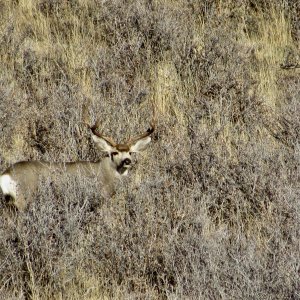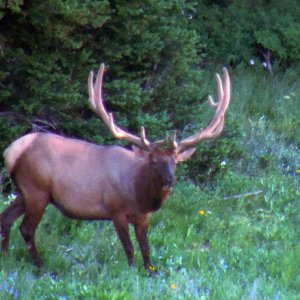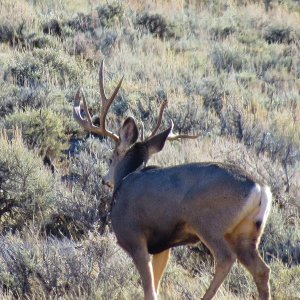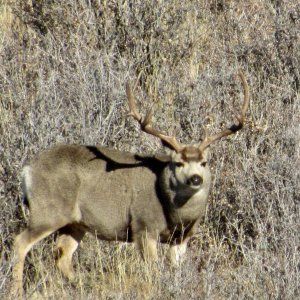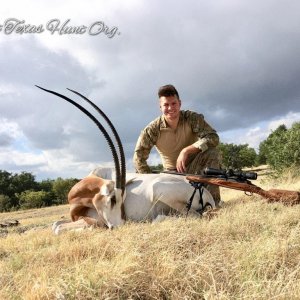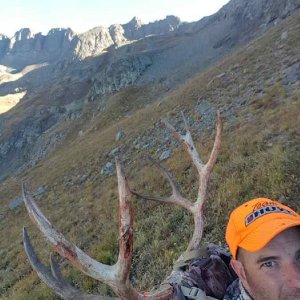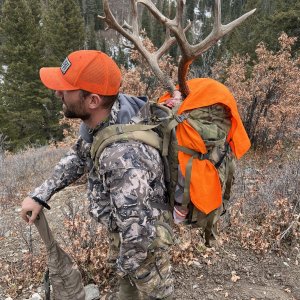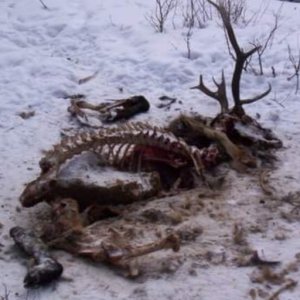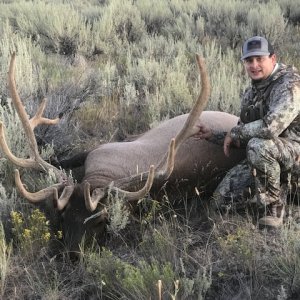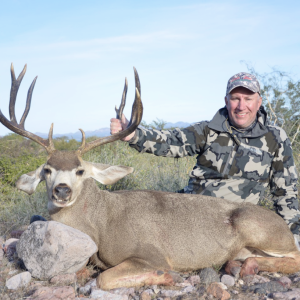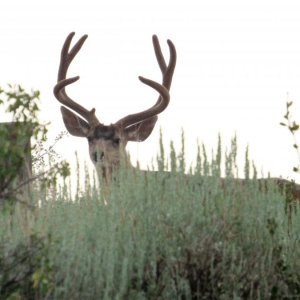W
Wildman
Guest
What Happened to Utah?s Mule Deer ?Hay Days??
Among Utah?s hunting community, there is nothing more discouraging than the decline of Utah?s mule deer herds over the last 30-40 years. There are many philosophies as to why this is the case: a loss of resources necessary for deer health, a lack of predator control, increased elk numbers, more sophisticated hunting technologies, changes in weather patterns and deer killed on the highways. I am in no way suggesting that any of these philosophies haven't contributed to the decline, but there is evidence to suggest that a loss of resources necessary for deer health may be the driving force behind the decline.
Sixty four percent of the land in the State of Utah is controlled by the federal government. The vast majority of the wildlife in the state live on federal land. Nothing has more impact on the health of wildlife in the state than the way these lands are managed.
In spite of the commonly held belief that before European settlement in the mid 1800?s the area which now makes up the State of Utah was a mule deer hunters paradise, the reality is mule deer were quite scarce at that time- particularly in the extremely arid central and southern parts of the state.
The lifestyles of the Native American peoples in these areas confirm this. Many of these tribes battled hunger constantly- often resorting to eating insects to stay alive. This fact suggests that there were not enough resources to sustain large deer herds which would have provided a relatively convenient source of nutrition.
The accounts of early European explorers further confirm that the area was lacking resources. Based on these reports, thousands of European settlers avoided the area preferring to travel several hundred more miles to the more fertile regions to the west and northwest.
When the Mormon settlers decided to settle in the region, they were widely criticized for poor judgment because of the harsh conditions of the area. These harsh conditions are evident in the history of Mormon settlement. Their battles with drought and insects are well documented.
Because there was barely enough wildlife to support even the small Native American tribes in the area, Mormon settlers introduced cattle to the region. These cattle quickly overwhelmed the scarce resources and lead to the well documented overgrazing of the vegetation of the region.
As it became increasingly obvious that the resources weren't keeping up to the demands placed upon them by the cattle, solutions were sought to resolve the problem. Since cattle were a vital part of the food supply, removing the cattle was not a consideration. The only solution that didn't involve people going hungry was to try to improve the productivity of the ranges.
Over the next several decades, the land management agencies in cooperation with agricultural producers implemented large scale range improvement practices directed at increasing the productivity of the ranges. These practices included burning, chaining, logging, reseeding and the development of water sources.
Over time, the ranges became more productive than they were before Mormon settlement. This increase in production benefited the cattle, but it also benefited the wildlife significantly. As the ranges became more productive, the number of mule deer began to increase. These practices culminated with the massive mule deer populations of the mid twentieth century.
Unfortunately, just as the benefits of productivity based range management were reaching their climax, a new range management philosophy was beginning to evolve. This range management philosophy is an adaptation of the ideas of Aldo Leopold.
Leopold was a native Iowan who grew up as a hunter and outdoorsman. His interest in the outdoors led him to pursue a college education at Yale University in Forestry. Upon graduation, he accepted a position with the U. S. Forest Service in New Mexico and Arizona.
As an avid outdoorsman, Leopold enjoyed hunting. Wolves were prevalent at the time, and Leopold took great pleasure in killing them. It was on one of these hunts that he had an epiphany.
After shooting a female wolf, he walked up to the wolf which had not yet died. The wolf raised its head and looked at him. The look in the wolf?s eyes caused him to question his justification for shooting her. This experience led Leopold to rethink his philosophy of natural resource management.
He wrote about his altered philosophies in a book published shortly after his death. In the book, ?A Sand County Almanac?, Leopold described his new philosophy as ?The Land Ethic?. He summarized this idea with the words, ?A thing is right when it tends to preserve the integrity, stability, and beauty of the biotic community. It is wrong when it tends otherwise.?
Exactly what Leopold intended for the future of land management is open to interpretation. There is evidence that he believed this ethic had its limitations. In his book, he says, ?A land ethic of course cannot prevent the alteration, management, and use of these ?resources,? but it does affirm their right to continued existence, and, at least in spots, their continued existence in a natural state.?
Whatever Leopold?s intentions were, the end result was a complete reformation of natural resource management policies over the next several decades. These new policies were based on the idea that most human intervention in nature is bad and that any human intervention in nature should be directed toward restoring landscapes to their pre-European state.
Because of this new philosophy, the traditional range improvement projects that created the abundant deer herds of the mid twentieth century were gradually phased out. Chaining came to a virtual standstill. Reseeding projects were largely abandoned. The reseeding projects that continued focused on restoring pre-European plants rather than increasing productivity. Managed fires of any significance became a thing of the past even though naturally occurring fires continued to be suppressed. Timber production went to almost zero, and water improvements on the ranges were left in disrepair.
With the lack of traditional range improvements, the productivity of the lands decreased. As the productivity of the land decreased, the competition for remaining resources increased. Ranges which cattle and wildlife had shared to their mutual benefit could no longer support either. The addition of elk to the area compounded the problem.
This shortage of resources is often blamed on the ?poor management of the last 100 years?. It is insinuated that if cattle grazing hadn't been allowed for the last 100 years we would have thriving deer herds. The fallacy of that argument is that mule deer were not as abundant in the pre-European settlement era as they were in the 1960?s.
The reality is, if we want thriving deer herds, we have to realize they were created by a philosophy of improving range productivity through management.
If we want to hold on to the ?all natural? philosophy, we better be willing to let fires burn through subdivisions and get used to intense competition for limited resources.
Among Utah?s hunting community, there is nothing more discouraging than the decline of Utah?s mule deer herds over the last 30-40 years. There are many philosophies as to why this is the case: a loss of resources necessary for deer health, a lack of predator control, increased elk numbers, more sophisticated hunting technologies, changes in weather patterns and deer killed on the highways. I am in no way suggesting that any of these philosophies haven't contributed to the decline, but there is evidence to suggest that a loss of resources necessary for deer health may be the driving force behind the decline.
Sixty four percent of the land in the State of Utah is controlled by the federal government. The vast majority of the wildlife in the state live on federal land. Nothing has more impact on the health of wildlife in the state than the way these lands are managed.
In spite of the commonly held belief that before European settlement in the mid 1800?s the area which now makes up the State of Utah was a mule deer hunters paradise, the reality is mule deer were quite scarce at that time- particularly in the extremely arid central and southern parts of the state.
The lifestyles of the Native American peoples in these areas confirm this. Many of these tribes battled hunger constantly- often resorting to eating insects to stay alive. This fact suggests that there were not enough resources to sustain large deer herds which would have provided a relatively convenient source of nutrition.
The accounts of early European explorers further confirm that the area was lacking resources. Based on these reports, thousands of European settlers avoided the area preferring to travel several hundred more miles to the more fertile regions to the west and northwest.
When the Mormon settlers decided to settle in the region, they were widely criticized for poor judgment because of the harsh conditions of the area. These harsh conditions are evident in the history of Mormon settlement. Their battles with drought and insects are well documented.
Because there was barely enough wildlife to support even the small Native American tribes in the area, Mormon settlers introduced cattle to the region. These cattle quickly overwhelmed the scarce resources and lead to the well documented overgrazing of the vegetation of the region.
As it became increasingly obvious that the resources weren't keeping up to the demands placed upon them by the cattle, solutions were sought to resolve the problem. Since cattle were a vital part of the food supply, removing the cattle was not a consideration. The only solution that didn't involve people going hungry was to try to improve the productivity of the ranges.
Over the next several decades, the land management agencies in cooperation with agricultural producers implemented large scale range improvement practices directed at increasing the productivity of the ranges. These practices included burning, chaining, logging, reseeding and the development of water sources.
Over time, the ranges became more productive than they were before Mormon settlement. This increase in production benefited the cattle, but it also benefited the wildlife significantly. As the ranges became more productive, the number of mule deer began to increase. These practices culminated with the massive mule deer populations of the mid twentieth century.
Unfortunately, just as the benefits of productivity based range management were reaching their climax, a new range management philosophy was beginning to evolve. This range management philosophy is an adaptation of the ideas of Aldo Leopold.
Leopold was a native Iowan who grew up as a hunter and outdoorsman. His interest in the outdoors led him to pursue a college education at Yale University in Forestry. Upon graduation, he accepted a position with the U. S. Forest Service in New Mexico and Arizona.
As an avid outdoorsman, Leopold enjoyed hunting. Wolves were prevalent at the time, and Leopold took great pleasure in killing them. It was on one of these hunts that he had an epiphany.
After shooting a female wolf, he walked up to the wolf which had not yet died. The wolf raised its head and looked at him. The look in the wolf?s eyes caused him to question his justification for shooting her. This experience led Leopold to rethink his philosophy of natural resource management.
He wrote about his altered philosophies in a book published shortly after his death. In the book, ?A Sand County Almanac?, Leopold described his new philosophy as ?The Land Ethic?. He summarized this idea with the words, ?A thing is right when it tends to preserve the integrity, stability, and beauty of the biotic community. It is wrong when it tends otherwise.?
Exactly what Leopold intended for the future of land management is open to interpretation. There is evidence that he believed this ethic had its limitations. In his book, he says, ?A land ethic of course cannot prevent the alteration, management, and use of these ?resources,? but it does affirm their right to continued existence, and, at least in spots, their continued existence in a natural state.?
Whatever Leopold?s intentions were, the end result was a complete reformation of natural resource management policies over the next several decades. These new policies were based on the idea that most human intervention in nature is bad and that any human intervention in nature should be directed toward restoring landscapes to their pre-European state.
Because of this new philosophy, the traditional range improvement projects that created the abundant deer herds of the mid twentieth century were gradually phased out. Chaining came to a virtual standstill. Reseeding projects were largely abandoned. The reseeding projects that continued focused on restoring pre-European plants rather than increasing productivity. Managed fires of any significance became a thing of the past even though naturally occurring fires continued to be suppressed. Timber production went to almost zero, and water improvements on the ranges were left in disrepair.
With the lack of traditional range improvements, the productivity of the lands decreased. As the productivity of the land decreased, the competition for remaining resources increased. Ranges which cattle and wildlife had shared to their mutual benefit could no longer support either. The addition of elk to the area compounded the problem.
This shortage of resources is often blamed on the ?poor management of the last 100 years?. It is insinuated that if cattle grazing hadn't been allowed for the last 100 years we would have thriving deer herds. The fallacy of that argument is that mule deer were not as abundant in the pre-European settlement era as they were in the 1960?s.
The reality is, if we want thriving deer herds, we have to realize they were created by a philosophy of improving range productivity through management.
If we want to hold on to the ?all natural? philosophy, we better be willing to let fires burn through subdivisions and get used to intense competition for limited resources.

